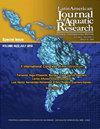Surf-zone fish assemblage structure and its diel variability in an ocean beach of Espírito Santo (Central Brazilian coast)
IF 0.8
4区 农林科学
Q3 FISHERIES
Latin American Journal of Aquatic Research
Pub Date : 2023-02-28
DOI:10.3856/vol51-issue1-fulltext-2925
引用次数: 0
Abstract
We characterized the surf-zone fish assemblage structure of an ocean beach on the central coast of Brazil (Guriri Beach, Espírito Santo) and assessed its diel variability. Like the entire Espírito Santo coast, Guriri Beach was also affected by ore tailings from the Fundão dam, which collapsed on November 5, 2015. Monthly samplings were carried out before the dam collapse along a year cycle (May 2013-April 2014), during the day and night in the neap tide, using a beach seine. A total of 2217 specimens were caught (1017 during the day and 1200 at night), distributed in 36 fish species and 20 families. Juveniles of the kingcroaker Menticirrhus spp., great pompano Trachinotus goodei, Florida pompano Trachinotus carolinus, littlescale threadfin Polydactylus oligodon, and Atlantic sabretooth anchovy Lycengraulis grossidens dominated the fish fauna, accounting for 84% of the total capture. The fish assemblage structure changed irregularly between day and night throughout the year. P. oligodon and Menticirrhus spp. were more abundant at night, whereas T. carolinus and L. grossidens were more abundant during the day. In most cases, no significant change was detected in fish abundance and richness between the day and night; when significant differences were detected, abundance and richness were higher at night. Our findings could support a monitoring program of the local surf-zone fish fauna and serve as before-impact data, allowing more accurate quantification of the ore tailings' impacts on the local fish biodiversity.Espírito Santo(巴西中部海岸)海洋海滩的冲浪区鱼类组合结构及其多样性
我们描述了巴西中部海岸海洋海滩(Guriri海滩,Espírito Santo)的冲浪区鱼类组合结构,并评估了其diel变异性。与整个Espírito Santo海岸一样,Guriri海滩也受到fund o大坝尾矿的影响,该大坝于2015年11月5日坍塌。在大坝坍塌前(2013年5月- 2014年4月),使用海滩围网在小潮的白天和晚上进行了每月一次的采样。共捕获标本2217只(白天1017只,夜间1200只),分布于20科36个鱼种。鱼类区系以金鱼Menticirrhus spp.、大梭子鱼Trachinotus goodei、佛罗里达梭子鱼Trachinotus carolinus、小鳞梭子鱼Polydactylus oligodon和大西洋剑齿鱼Lycengraulis grossidens的幼鱼为主,占捕获总量的84%。鱼类群落结构全年昼夜变化不规律。P. oligodon和Menticirrhus在夜间最多,T. carolinus和L. grossidens在白天最多。在大多数情况下,鱼类的丰度和丰富度在白天和黑夜之间没有显著变化;当检测到显著差异时,丰度和丰富度在夜间更高。我们的研究结果可以支持当地冲浪区鱼类动物群的监测计划,并作为影响前的数据,可以更准确地量化尾矿对当地鱼类生物多样性的影响。
本文章由计算机程序翻译,如有差异,请以英文原文为准。
求助全文
约1分钟内获得全文
求助全文
来源期刊

Latin American Journal of Aquatic Research
FISHERIES-MARINE & FRESHWATER BIOLOGY
CiteScore
1.70
自引率
10.00%
发文量
44
审稿时长
4-8 weeks
期刊介绍:
Latin American Journal of Aquatic Research- LAJAR is the continuation of the journal Investigaciones Marinas (1970-2007) and is published since 2008 by the Escuela de Ciencias del Mar, Facultad de Ciencias del Mar y Geografía of the Pontificia Universidad Católica de Valparaíso. LAJAR is an “Open Access” journal that publishes in English language, original research articles, reviews and short communications on aquatic science, which contain the results of research conducted in aquaculture or in oceanic and coastal marine waters of Latin America.
The following topics are considered: Physical Oceanography, Chemical Oceanography, Marine Biogeochemistry, Marine Pollution and Toxicology, Marine Geology and Geophysics, Biological Oceanography, Fisheries and Aquaculture.
 求助内容:
求助内容: 应助结果提醒方式:
应助结果提醒方式:


